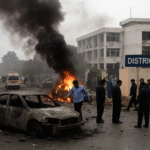The 80th session of the United Nations General Assembly in September 2025 saw the unveiling of one of the most ambitious proposals yet for ending the Gaza war: a 21-point U.S. peace plan. Framed as a blueprint for a ceasefire, reconstruction, and eventual Palestinian statehood, the plan is meant to offer a “political horizon” for both Palestinians and Israelis.
Yet the plan immediately sparked controversy — not only from Israel and Hamas but also from Arab and Muslim states who criticized it as one-sided and potentially entrenching Israeli dominance rather than ending it.
Key Elements of the Gaza Plan
The U.S. proposal is comprehensive, addressing security, governance, and humanitarian relief. Its central pillars include:
- Ceasefire and Hostage Release – An immediate halt to fighting, followed by the release of hostages and remains within 48 hours, and a partial Israeli prisoner release.
- No Forced Displacement – Gaza residents cannot be forced out, and those who left have the right to return.
- Reconstruction Effort – A donor-funded rebuilding program, special economic zone, and major infrastructure restoration projects.
- Transitional Governance – Gaza to be run by a technocratic committee under international oversight, later transitioning to a reformed Palestinian Authority (PA).
- Disarmament of Hamas – Hamas would be removed from power, its military wing dismantled — a key Israeli demand.
- International Security Force – Deployment of a multinational stabilization mission to secure Gaza and train a Palestinian police force.
- Political Horizon – A phased process ultimately aimed at creating conditions for a Palestinian state.
Criticism and Controversy
The plan’s unveiling at the UN was followed by a wave of objections across the Arab and Muslim world. Critics argue that far from being a balanced peace initiative, it risks cementing Israeli control while weakening Palestinian self-determination.
1. One-Sided Disarmament
Arab diplomats have openly called the plan an attempt to “disarm the victim while leaving the occupier fully armed.” By demanding the dismantling of Hamas’s military capabilities but offering no parallel restrictions on Israel’s armed forces, the plan is seen as legitimizing Israel’s military superiority without guaranteeing Palestinian security.
2. Lack of Enforcement on Israel
Several Arab foreign ministers warned in closed-door meetings that the plan lacks any mechanism to prevent future Israeli raids, blockades, or air campaigns in Gaza. Without such guarantees, they argue, Israel would retain unilateral freedom to strike Gaza at will — undermining the spirit of the ceasefire.
3. Tony Blair’s Role and Western Oversight
The rumored leadership of the Gaza International Transitional Authority (GITA) by former UK Prime Minister Tony Blair triggered intense criticism. Blair’s earlier tenure as Middle East Quartet envoy was widely viewed as biased toward Israel, and his appointment was described by Arab commentators as “a colonial-era solution repackaged for the 21st century.”
4. Undermining Palestinian Political Legitimacy
By excluding Hamas entirely and keeping the PA’s authority conditional on external “reforms,” the plan is accused of imposing governance from abroad rather than fostering an organic Palestinian political consensus. Critics warn this could deepen internal Palestinian division and make the plan unenforceable on the ground.
5. Public Perception and Legitimacy
Arab media outlets and commentators described the plan as a “security blueprint for Israel” rather than a genuine peace initiative. Popular sentiment in Gaza and the wider Arab street remains deeply suspicious, with fears that this is a pathway to permanent subjugation rather than freedom.
Israel, PA, and Hamas Responses
- Israel cautiously welcomed the disarmament clause but rejected any step leading to a Palestinian state “within miles of Jerusalem.” Netanyahu insisted Israel must maintain operational freedom — reinforcing Arab concerns about unchecked Israeli power.
- The Palestinian Authority (PA) welcomed the opportunity to return to Gaza but stressed that sovereignty must be real, not symbolic.
- Hamas dismissed the plan entirely, calling it a surrender document designed to strip Gaza of its ability to resist occupation.
A Divisive Beginning
Because of this immediate backlash, the Gaza Plan begins its journey as one of the most polarizing peace initiatives in recent history. Arab governments are split between those willing to back it as a first step and those warning it could ignite greater instability if imposed without local legitimacy.
Conclusion
The Gaza Plan is the boldest attempt yet to stop the war and chart a political path forward, but its reception has been deeply polarized. Its insistence on Hamas disarmament without reciprocal restraints on Israel, its reliance on international trusteeship, and its perceived Western bias make it controversial from the outset.
For this initiative to succeed, it must go beyond being a security plan for Israel and become a genuine political roadmap that addresses Palestinian grievances, guarantees their safety, and restores their agency. Otherwise, it risks becoming yet another failed attempt at solving one of the world’s most enduring conflicts.










